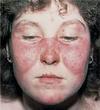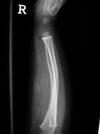Peds_Exam3 Flashcards
(76 cards)
1
Q

A
- Osteomyelitis
- Children
- Staph infecction, through bloodstream
2
Q

A
- Avascular Necrosis
- Common in shoulder and hip
- Caused by sickle, steroids, or fractures
3
Q

A
- Slipped Capital Femoral Epiphysis
- onset of puberty 13 years.
- boys, obesity
- osteonecrosis complication
4
Q

A
- Legg Calve-Perthes Disease
- aseptic necrosis of femoral head
- boys 4-8 years
- skeletal age below chronological age
5
Q

A
- Osteogenesis Imperfecta
- most common osteoporosis syndrome in children
- light touching can cause a fracture.
6
Q

A
- Juvenile Rheumatoid Arthritis
- autoimmune inflammatory process
- female predominse
- 2-3 years, or 8-10 years
7
Q

A
- Developmental Dysplasia of the Hip
- dislocation, shallow acetabulum, subluxation
- born breech
- 80% females
- limited hip abduction
8
Q
What is this used for?

A
- Tx of DDH, preventing skin breakdown
9
Q
What is this?

A
- Congenital Club Foot
- forefoot adduction,
- midfood supination
- hindfoot varus
- ankle equinus
10
Q
What is the other name for this?

A
- Subluxation of the Radial Head
- children 1-3 years
- partial dislocation
11
Q
- What should you do if signs of nero impairment in a child with cast or brace?
- What psychological affects from wearing a brace or disabling condition?
- What are fractures indicative of?
A
- Contact HCP
- altered role performance, body image, fear, anger, isolation
- rare, warrant further investigation to rule out abuse
12
Q
- Priority Action for Extremity Fracture
- What assessment provides the earlies indication of an improvement, or detioration in neurological condition
- Action if cervical or spinal injury is suspected?
A
- Assess, immobilize extremity, if compound fracutre, cover with sterile dressing, elevate, COLD, monitor neuro stat, transport ER
- LOC
- immobilize neck and spine
13
Q
- If spinal injury is ruled after head injury, what is appropriate action?
- What are seizure precautions?
A
- elevate HOB 15-30 degrees, for venous drainage
- Raise side railes when sleeping, padding, waterproof mattress, carry med ID, should swim with companion, wear a helmet, alert caregivers
14
Q
- Signs of Brainstem involvement x5
A
- Deep, rapid or intermittent gasping respirations
- fluctuations or slowing of pulse
- fluctuations in BP
- Sluggish, dilated or unequal pupils
- NOTIFY HCP IF THESE SIGNS DEVELOP
15
Q
- What does drainage from nor or ears pos for glucose indicate?
- What is communicating hydrocephalus?
- What is noncommunicating hydrocephalus
A
- leakge of CSF, notify HCP
- impaired absorption w/in subarachnoid space
- obstruction of CSF in ventricular system
16
Q
- What could a high shrill cry be indicative of?
- It is appropriate to place tongue blade airway device over child’s mouth during a seizure
- What is a priority for a child with autism
A
- Increase Intracranial Pressure
- FALSE
- Ensuring a safe environment
17
Q
- Interventions for a seizure
A
- Ensure airway patency
- suction equipmen/oxygen available
- time the seizure
- ease child to floor, side lying position
- pillow under child’s head or own hands
- loosen clothing
- remove eye glassees
- clear the area
- prep meds
18
Q
Sickle Cell
- What is a vaso occlusive crisis
- what is a splenic sequestration
- hyperhemolytic crisis
A
- stasis of blood with clumping of cells, ischemias, infraction. Fever, swelling in hands, feet, joints abdomen
- pooling and clumping of blood in the spleen, profound anemia, hypovolemia, shock
- rapid RBC destruction, jaundice, anemia, reticulocytosis
19
Q
- What is an aplastic crisis
- What medication should be avoided for sickle cell disease?
- How should liquid iron be taken
A
- diminished RBC, caused by viral infection or lack of folic acid, anemia and pallor
- meperidine, can induce seizure
- thru straw, brush teeth after (stains the teeth)
20
Q
- What is hemophilia A
- what is hemophilia B
- What should be worn if child has a bleeding disorder?
A
- result of factor deficient VIII
- result of factor deficient IX
- Medic alert bracelet
21
Q
- Parent teaching child with mono
- Signs of splenic rupture
- How long do symptoms of flu last?
A
- monitor for splenic rupture,
- ab pain, LUQ pain, and left shoulder pain
- One week
22
Q
- Priority Action for administering Parenteral Vaccine
A
- verify prescription
- immunization hx
- info to parents
- parental consent
- lot #, expiration date, prep injection
- appropriate site
- admin
- document
- record for parents
23
Q
- Preterm children and vaccine admin
- Vaccine at 1month
- Vaccine at 2 months
A
- full dose at appropriate chornological age
- Hep B
- IPV, DTap, Hib, PCV, Rotavirus
24
Q
- Vaccine at 12-15 months
- Vaccine at 15-18 months
- Vaccine at 12-33 months
A
- Hib, PCV (pneumo), MMR, Hep A (2nd dose @ 6-18 months)
- dTAP
- Hep A
25
1. Vaccine at 4-6 years
2. Vaccine at 11-12 years
1. Dtap, IPV, MMR, Varicella
2. MMR, Tdap, MCV4 (meningitis), HPV
26
What is this?

* Non communicating hydrocephalus
* CSF in ventricles
27
What is this an example of?

* Ventriculoperitoneal shunt
* 10% infection rate
28
What is this?

1. Craniosynostosis
2. premature closure of cranial sutures. Elongated skull
3. surgical intervention (before 6 months of age)
29

* Epidural hematoma
* between dura and skull
30

* Subdural hematoma
* between dura and rachnoid membrane
31
What is this?

* Intracerebral Hemorrhage
32
* What type of head injury is this?

Focal head injury
33
What type of head injury is this

Coup Contra Coup
34
this represents?

* Bacterial meningitis
* thank pneumo, and HIB vaccine
35
What is this indicative of?

* Meningitis
* cannot straighten leg
* stiff hamstrings
36
What is this indicative of\>

* **Meningitis**
* neck stiffness
* causes hips/knees to flex
37

* **Meningococcemia**
* death within hours
* spread via or or nasal droplet
* incubate 2-10 days
38
What is this called

* Aseptic Meningitist (nonbacterial)
* signs develop 1-2 days after onset. Insidious
39

* **encephalitis**
* (bacteria, fungi, protozoa, virus)
* Most virus- measles, varicella, entero, herpes, west nile
40

* Leukocoria- Cat's Eye Reflex
* sign of retinoblastoma
* may have strabismus
* 10yr, 90% survival
41

* glossitis
* inflamed tongue
* sign of *anemia*
42
What is this called?

* Koilonychia
* sign of anemia
* spoon fingernails
43

* **Idiopathic thrombocytopenic purpura**
* excess destruction of platelets
* autoimmune
* *prednisone, IVIG (globulin)*
* anti-D antibody
* Splenectomy
44

* **Disseminated intravascular coagulation**
* bleeding and clotting simulatenously
* hypoxia, shock ,acidosis, burns, sepsis
* hypotension
* organ dysfunction from infarction/ischemia
45

* HSP, common
* protein in the urin (nephritis)
* followed by URI
* 2-11 yr range, more in boys
* monitor BP
* watch salt intake
46

* **Systemic lupus erythematosus**
* 10-19 years
* more in females
* autoimmune of blood vessels and connective tissue
* tx- steroids, NSAIDS, diet exercesie, less sun exposure
47

* **Wiscott Aldrich Syndrome**
* thrombocytopenia (increased bleeding)
* eczema
* immunodeficiency (B & T lymphocytes)
* X-linked recessive
* herpes, chronic pulmonary disease, sinusitis, otitis media
48

* Shingles
* 25% who had chickenpox will get this
* Varicella Zoster
* 50yrs+
* tingling or burning on one side of the body
49

* **Roseola**
* measles, herpes type 6
* enters through nasal, buccal or conjuctival. Adult saliva
* 6-15 months
* Tx: Tylenol or motrin, cool mist, tepid baths, bland diet, fluids
* isolation until 5th day of rash
* start on trunk and spread to face, neck
50

* **Rubella, German Measles**
* naso secretions, blood stool
* starts at face and spreas downward
* avoid contact with preg women
51

* **mumps**
* paramyxovirus
* unilateral or bilateral, parotid gland (parotitis
* painful tender
* reaches max in 1-3 days
* from saliva
* hot/cold compress to neck, fluids, soft diet, tylenol/mortrin
52

* **Coxsackie**
* direct contact with nose, throat discharge, stool
* \<10 yrs
* herpangina (throat blisters)
* 1-2 days after symptoms
* rash on hands feet
* tylenol/motrin
53

* **Diptheria**
* cornebacterium, diptheriae
* discharge from mucous of nose, pharynx, skin or other lesionso
* direct contact
54

* **Fifth Disease**
* Human parvovirus
* school aged
* transmission- respiratory secretions, blood
* slapped cheek disappears 1-4 days, red rash reappears. may go away but reappears with sun, heat or cold
55

* **impetigo**
* strep, staph, mrsa
* autoinoculable contagious
* honey colored crusts, itching
* tx: antibiotics, antibacterial ointment
56

* **Tinnea Corporis**
* dermatophytes (fungus), trichophyton, microsporum, epidermophyton
* animals to human,
* Annular lesions
* Tx: antifungal cream, ketoconazole, 2x a day for 6-8 weeks
57

* **tinea capitis**, ringworm of the scalp
* dermatophytes
* person to person, or animal to person
* crusty lesions in the scalp
* oral antifungal agents for 6-8 weeks
* watch liver
58

* pediculosis capitis, head lice
* blood sucking parasite
* white eggs (nits)
* behind ears, nape of neck, occipital
59

* Scabies
* mites, sarcoptes scabiei
* intense pruritis
* axillary cubital, politeal folds, inguinal region
* under 2- feet and ankles
* over 2- hands, wrists
* Elimite 5% cream applied head to toe, repeat week later
60

* **Muscular Dystrophy**
* most important single grp of muscle diseases in childhood
* degeneration of muscle fibers
* metabolic disturbance unrelated to nervous system
61

* **Meningocele**
* encases meninges and spinal fluid
* NO neural elements, not neurologic deficits
62

* Myelomeningocele
* meninges, spinal fluid and nerves
* neurologic deficits occur
* Latex allergy
63

* **Duchenne**
* most severe and most common
* x-linked trait
* males exclusively
* 3-5 years
* calp muscle hypertrophy
* loss of independent ambulation by 9-12 years
* progression until death from respiratory or cardiac failure
* Bipap
64

* **Spinal muscular atrophy , Werdnig Hoffmann Disease**
* floppy infant syndrome
* manifests before 6 months
* death can occur as a result of respiratory failure by age 2
* no cure
* may need trach, ventilation, oxygenation
* verbal, tactile and auditory stimulation
* social interaction
* autosommal recessive

65

* **Guillain Barre Syndrome, polyneuritis**
* 4-10 years
* immune mediated disease
66

* **Infantile Botulism**
* food poisoning from Costridiium botulinum
* inhibits acetylcholine at nerumuscular junction
* impaired motor activity
* vary from constipation to neurologic dysfunction, respiratory failure
* cranial nerve deficits (loss of head conrol, weak cry, reduced gag reflex
* 2-4 months of age
* no honey in infants less than 12 months
67

68
Name this type of fracture

plastic deformation, "bowing"
69
what type of fracture is this?

greenstick, doesn't go all the way through the bone
70
what type of fracture is this?

torus
71

72

balanced suspension traction. With/Without skin or skeletal traction
73

Cervical/Halo Traction
74

* *Decerebrate*- lesions of the upper part of the brainstem or severe bilateral lesions of the cerebrum;
* *Decorticate*-structural lesions of the thalamus, internal capsule, or cerebral white matter. (unilateral/bilateral)
75

* **Spina Bifida Occulta**
* cause is *abnormal adhesion or tethering*
* most common in the lumbosacral area (L5 and S1)
76
Rubeolla
Koplik Spots


